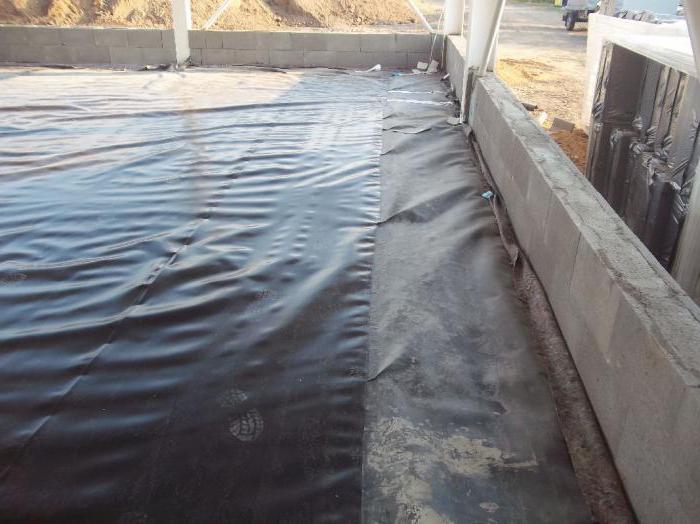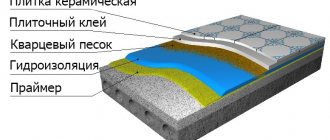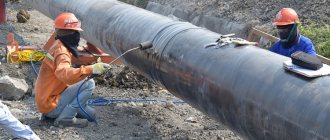Floor waterproofing is a complex of finishing works aimed at creating a water-repellent or drainage barrier. Insulation work is carried out at the stage of arranging the subfloor, before leveling the surface for laying the floor covering and arranging various heating systems.
To carry out these works, there are many technologies using various materials. The method of carrying out the work depends on the type of premises, flooring, number of storeys of the building, etc.
Insulation requirements

General layout of the floor and various protective barriers
According to SNIP, waterproofing of the floor is required for arrangement with a medium and high degree of exposure to wastewater and penetrating moisture.
Under the medium and high degree of impact intensity is understood as the periodic ingress of moisture on the floor surface, water flowing down the walls of the room, constant or frequent wetting, and the presence of water on the surface of the floor covering.
That is, waterproofing works in bathrooms and toilets are carried out at the finishing stage without fail.
The thickness of the insulating layer, according to building codes and regulations, is determined by the type of work and the material for waterproofing the floor. The choice of a specific work technology depends on a number of factors and requires an assessment of the condition of the floor covering, a visual inspection of the floor slab, the floor, the cost of work and the volume of the room.
Preparatory work
First, the surface is prepared by dismantling the previous coating. It is advisable to remove it to the concrete base. All protruding parts are cut off with a grinder or cleaned so as not to damage the waterproofing. The debris is swept out and the dust is vacuumed to prepare the surface for patching cracks. Deep gaps are widened and cleaned, after which they are poured with a cement-sand mixture. If the gap is too wide, it is reinforced with a special mesh or metal rods. The surfaces are allowed to harden, and then they are sanded to make it even.
If waterproofing a wooden floor, all boards should be fixed so that they do not bend. If necessary, a poor-quality coating is partially or completely replaced. Water-repellent films are not placed on cardboard or plywood as these materials have a short lifespan.
Along the perimeter of the room, the joints of the walls with the floor are sealed with cement so that a rounding is obtained. Thanks to this, the material will not bend when it is installed on the walls. After the solution has solidified, the surface is primed 2 times. Then, around the perimeter of the room, coatings are applied or self-adhesive waterproofing materials are laid to protect the joints from moisture.
Types of insulation for private houses and apartments
Floor protection in private houses, residential and technical premises can be performed using various technologies, which involves the use of a variety of modern materials and coatings.


Waterproofing floors in wet rooms
By the method of application, the following types of waterproofing are distinguished:
- Roll (pasting).
- Coating (painting).
- Cast.
- Plastering.
- Penetrating.
Any technology involves a full range of preparatory measures aimed at preparing the surface to be treated and the room as a whole.
Products and services
There are several brands of roll-on waterproofers on the domestic market.But most often floors and other surfaces are protected from moisture using the materials manufactured. Waterproofers of this brand are distinguished by simply remarkable performance characteristics. Basically, two types of materials from this manufacturer are suitable for finishing floors - glued "Technoelast Prime" and fused "Technoelast Thermo". Also on sale there is a special self-adhesive membrane of this brand, intended for indoor use.


Good quality at not too high cost - this is what distinguishes TechnoNIKOL, roll waterproofing. The price for a self-adhesive membrane from this manufacturer, for example, is only about 1300-1500 rubles. (10 / 0.75 m). The materials of this particular manufacturer are considered a good alternative to a less durable and durable budget roofing material. Their guaranteed service life is 25-30 years.
Features of the use of roll coatings
Rolled or glued floor waterproofing is the most economical and affordable insulation option, which provides for the flooring of one or more layers of moisture-repellent material.


Polyester with bitumen impregnation on the outside
The following types of coatings act as a basis for waterproofing material:
- cardboard - nowadays it is rarely used, since due to its organic origin, the material is subject to decay processes. In order to save money, it can be used in places with low intensity of exposure to moisture;
- fiberglass - a base with high insulating performance, does not rot and has a long service life. In the process of work, it requires accuracy, since it has low tensile strength and elongation;
- fiberglass is an elastic and strong enough base. Laying should be done in two or more layers. This is due to the structure of the material and its connection to the outer layers of bitumen;
- polyester is a modern material with high strength characteristics. Recommended for laying in places where strong deformations of the waterproofing layer are possible.
For impregnation of the base from the outside and inside, a mixture of bitumen and basalt chips with the addition of polymer fillers is used. Polymers provide improved performance and give the material additional thermal insulation properties.


Laying roll coverings by heating to high temperatures
Roll materials can be laid in three ways:
- Mechanical fastening - the coating is laid under the screed, sub-floor or embankment. The docking points are connected with fasteners or using a self-adhesive base.
- Fusion - the material is heated using a gas torch or heat gun.
- Bonding - laying is done using bituminous mastics and special compounds. The choice of adhesive base depends on the indoor temperature and the thickness of the insulation layer.
When laying waterproofing under a concrete self-leveling floor or screed, use polyethylene and polypropylene films. Such material provides the creation of a monolithic coating without giving the concrete layer additional thickness.
Roll waterproofing and the principle of creation
The device of this waterproofing involves the following steps. First of all, the working surface is leveled, it is necessary to minimize the presence of voids and potholes between the material used and the concrete base. The best option would be to use an appropriate leveling component.
The floor is cleaned of dirt, dust; to create better adhesion, it should be primed. The purchased mixture is diluted with plain water and gently poured onto the surface.Processing with a needle roller will prevent the formation of bubbles inside the layer, provide high-quality insulation with your own hands.
The described waterproofing is usually laid from gluing materials, the adhesion of which is provided by adhesives or bitumen mastic. When working with polymer mastic, it is better to use fiberglass, polyisobutylene or polyvinyl chloride film. For working with bitumen mastic, brizol, gidrotekloizol, gidroizol, in general, all coatings containing bitumen are intended.


The principle of waterproofing the floor
A bituminous emulsion is applied to the prepared dry and clean floor in the apartment. Typically, such a composition is made on the basis of water, and throughout the entire operational period does not emit harmful impurities into the environment (living quarters). A primer is applied to the emulsion, the two layers of which must be crossed for better adhesion.
On the slightly dried first layer of the primer, joints and corners are mounted, which are applied using a special construction tape, which is sunk into the material with slight movements. When applying the second layer, these elements are processed especially carefully. Waterproofing a wooden floor involves the application of special protective components.
When the primer layer is ready, you can start applying the roll waterproofing. If the material is a self-adhesive carpet, it is simply laid on the surface and pressed against it. Working with conventional roll materials will require the use of a hot air gun and a burner. With the help of a burner, the material is heated from the outside and quickly pressed to the floor. It is especially good to melt the overlap and press it well.
It is imperative to create a waterproofing overlap on walls up to 30 cm high. As for the corners, they are finished with special patches and sealed.
At the end of all of the above points, a sealed and monolithic coating is formed, which is characterized by excellent adhesion to the surface. Immediately after the adhesive has completely dried or the bitumen has cooled, you can create a floor screed.
Works using liquid insulation


Floor insulation using bituminous mastic
A coating or liquid waterproofing for a floor is the application of a thin layer of a waterproof coating to the surface to be treated. Coating is carried out using a paint brush, roller or notched trowel.
The thickness of the layer varies depending on the waterproofing material used and does not exceed 2-5 mm.
The main components used in waterproofing are the following materials:
- Bitumen is the cheapest material used for coating and insulation works. Bituminous waterproofing is easy to apply, but has a short service life, no more than 5-6 years;
- Bituminous mastic is an elastic and more durable coating than conventional bitumen. It is produced with the use of additional polymer additives, which makes it possible to impart the desired properties and qualities to the final coating;
- Polymer varnish - modern and high quality coatings for floor insulation. Provide resistance to mechanical stress, chemical attack and a long service life. Recommended for waterproofing bathrooms and household premises.
These compounds are most often used to insulate the subfloor in a wooden house. You can find out more about this in the corresponding article on the site.
When carrying out work in apartments and private houses, it is recommended to use polymer-containing materials, since these coatings are more reliable, safe and provide a sufficient service life of the waterproofing layer.
When is waterproofing applied?
The need for protection from moisture arises during the construction of both private houses and basements of multi-storey buildings. If there is a need for waterproofing, then it is installed in kitchens, bathrooms and storage rooms. They make the foundations of the basement and first floors waterproof, and also apply a protective layer to the roofs.
Waterproofing performs a number of tasks:
- creates protection for the base made of wood or concrete from the negative effects of moisture and freezing temperatures;
- normalizes indoor humidity, prevents mold and mildew;
- increases the life of the foundation.
In buildings where waterproofing installation work has been carried out, there is no excess moisture and a microclimate favorable for rooms and humans arises.
Floor protection with plastering compounds
Plastering waterproofing of the floor is used when processing surfaces that are not subject to strong deformations and vibrations.
The main components for insulation are special mixtures and solutions based on cement, polymer additives and mineral additives. Most often, this type of waterproofing is used when working in basements, bathrooms and showers, swimming pools, etc.


Plaster mixes are well suited for leveling the floor laying the floor covering
Among the main mixtures and solutions for plaster insulation, the following materials can be distinguished:
- lime emulsion - is a cement mortar with the addition of lime, oleic acid, water and sulphurous alumina. Currently, it is used quite rarely and is often used to fill potholes, cracks and other damage;
- liquid glass - made with the addition of sodium or potassium components. Possesses a high degree of crystallization, antiseptic and adhesive properties. After application, it creates a reliable waterproof barrier, is widely used for waterproofing baths, garages, industrial premises;
- dry mixes and ready-made compositions - are made on the basis of cement and polymer additives. They are used both for waterproofing the floor of household premises and for insulating external surfaces. Produced in the form of dry and ready mixes.
Plaster waterproofing is often used as a leveling coating for laying ceramic tiles, granite slabs, and natural stone.
Polyethylene film
This type of waterproofing is also often used to protect the floor from moisture. Technical polyethylene film is best suited for this purpose. Its thickness is slightly greater than that of the usual one, and therefore, it is somewhat stronger. In terms of transparency, such material is inferior to the greenhouse, but in this case, of course, it does not play any role. Polyethylene technical film is cheaper than usual. In particular, such a roll-up waterproofing is well suited for a wooden floor. On top of it, a not too thick concrete screed is usually arranged or plywood is stuffed.


Using penetrating mixtures


General scheme of the influence of impregnating mixtures on concrete
Penetrating floor waterproofing is aimed at eliminating and filling pores, potholes and microcracks through which water seeps or outflows.
Mainly used for insulating concrete floors and walls, brick walls, foundation slabs and basements.
The waterproofing process takes place using special compounds consisting of Portland cement, fine-grained sand and polymer-chemical components. The active substances of the mixture, getting into the pores and damage to the concrete, form insoluble crystals that completely fill the voids.
This type of insulation does not impede the free circulation of air and vapors through the concrete, while maintaining high water-repellent and frost-resistant properties.
Related material: Waterproofing the floor in the apartment.
Features of work in the bathroom
Roll waterproofing for the bathroom floor is laid using a simpler technology. After all, you usually don't need to dismantle anything in such a room. The floors in the bathrooms of urban apartments are most often originally made of concrete. Therefore, the preparatory work in this case will most likely consist only in their alignment. All cracks and chips in the concrete coating must be sealed with a cement-sand mortar. You can start waterproofing the floor about two weeks after this procedure. In this case, the gluing of the roll material is carried out in the same order as in ordinary rooms. For better adhesion, concrete can be pre-primed with a deep penetration agent.
If you intend to later lay tiles in the bathroom, it is best to use a roll material based on fiberglass or fiberglass to protect the floor from moisture. Since this waterproofing option is highly durable, it can be leveled with a hard roller.
Average cost of various types
The final cost of any waterproofing work is made up of a number of factors.


Impregnating composition of the Penetron trademark
Basically, the following points affect the cost:
- condition and area of the treated surface;
- the required type of insulation;
- material used in the work;
- the cost of insulation work.
The average cost of work, excluding construction and consumables, is shown in the table below:
| Name of works | Square | Cost, rub) |
| Roll insulation in one layer | 1 m² | 320-350 |
| Two-layer coating insulation | 1 m² | 350-400 |
| Two-layer glued insulation | 1 m² | 350-380 |
| Insulation by rolls of material using bitumen-polymer mastic in two layers | 1 m² | 350-370 |
| Waterproofing protection of partitions and joints | 1 m² | 180-250 |
The cost of materials depends on the technology of work and the specific manufacturer. So, a roll coating for waterproofing a floor from Technonikol will cost 1,030 rubles per 10 square meters.
Dry mix for plaster insulation of the "Ceresit" trademark at 770 rubles per 25 kilograms. A dry penetrating mixture of the Penetron trademark at 1,500 rubles per 10 kilogram.
Waterproofing materials marking
An uninitiated person, when choosing one or another waterproofing material, can easily get lost in their variety. In order to somehow classify all types of waterproofing, there is their unique marking.
First, there is a letter in the marking, with the help of which the base material is indicated (E - polyester, T - fiberglass, X - fiberglass). Then comes the designation of the upper protective layer, on the composition of which the area of use of roll or sheet waterproofing will depend. So, the letter "P" means that a layer of polymer film was used in the production. The letter "K" marks building materials with a coarse-grained protective coating, "M" means that the protective layer consists of a fine-grained mixture.
The third letter determines what material the lower protective layer is made of. Many manufacturers of waterproofing materials most often use a polymer film, so many types of waterproofing have the letter P.
The letter marking is most often followed by numbers that indicate the weight of one square meter of material.
Waterproofing materials used indoors can be distinguished as a separate type. These include various films and membranes made from polyethylene, polypropylene and other polymers. Most often, membrane materials are used for waterproofing floors.
In the conditions of the central zone of the CIS countries, roll-up waterproofing for a polymer-based foundation is used most often.Also, this type of waterproofing material is laid during the construction of hydraulic structures and pools, during roofing work.





















